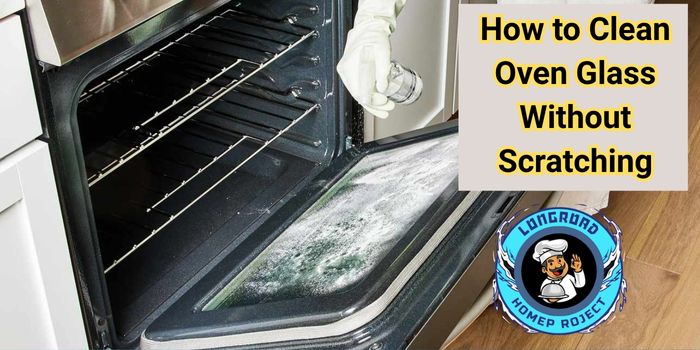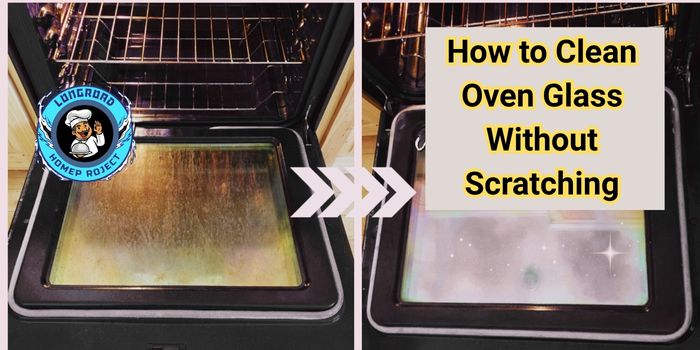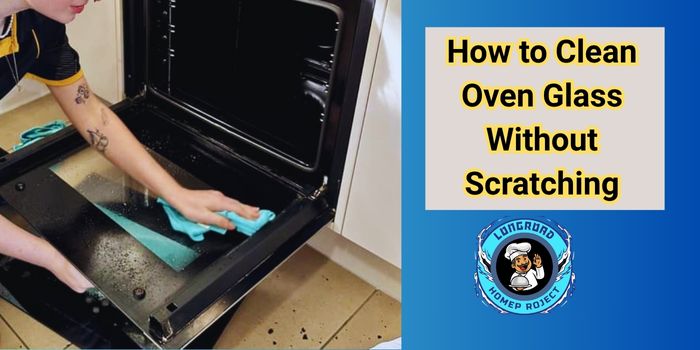As an Amazon Associate I earn from qualifying purchases.
If you’ve ever wondered how to clean oven glass without scratching it, you’re definitely not alone. Whether it’s after a big family roast or months of everyday cooking, that once-clear window now looks cloudy, greasy, or coated in stubborn brown stains. It’s frustrating—and even a little embarrassing when guests peek into your kitchen.
But here’s the thing: oven glass gets dirty because it’s exposed to constant heat, airborne grease, food splatters, and baked-on residue. Over time, this creates a tough, sticky film that clings to the inside (and sometimes outside) of the oven door. And once that grime sets in, scrubbing it off without damaging the surface becomes a real challenge.
The Sticky Science Behind the Mess
Let’s break it down. Every time you bake, roast, or broil, moisture, oils, and food particles escape. These vaporized fats settle on the cooler oven door glass and oxidize with repeated heating, turning into those brown or yellowish stains we all dread. Add sugar or acidic ingredients into the mix (think pies or tomato sauces), and that residue becomes even tougher to clean.
Unfortunately, reaching for heavy-duty cleaners or harsh scouring pads can do more harm than good. That brings us to our next point…
Why You Shouldn’t Just Scrub It Off
Many people instinctively grab steel wool, razor blades, or powdered cleansers to get the job done faster. Don’t. These tools can scratch the glass surface, permanently damaging the clarity of your oven window. Scratches aren’t just unsightly—they create grooves where grease and grime can settle even deeper, making future cleanings harder.
What’s more, scratched glass can weaken over time, especially with regular heating and cooling cycles. It may not shatter, but it won’t look clean even when it is.
So What’s the Safe Way to Clean It?
In this guide, we’ll walk you through the safest, most effective ways to clean your oven glass without scratching it. You’ll learn:
- What tools and natural ingredients work best
- What to avoid at all costs
- How to tackle even the most stubborn brown stains
- And how to keep your oven glass sparkling with minimal effort
Whether you’re a seasoned home cook or cleaning your oven for the first time, this guide will save you time, stress, and elbow grease. Let’s get started—your oven window is about to shine like new again.
What You’ll Need – Safe Supplies for Cleaning Glass Oven Doors
Before diving into the actual cleaning, it’s crucial to use tools and cleaners that won’t scratch or damage the glass. Oven door glass may be heat-resistant and tough, but it’s not immune to micro-abrasions caused by harsh pads or abrasive powders.
Here’s a list of safe, scratch-free supplies to have on hand:
Non-Scratch Tools
Microfiber cloths – Ultra-soft and perfect for wiping away grime without leaving streaks or scratches.
Non-abrasive sponges – Look for ones labeled “safe for glass” or “non-scratch.” Avoid steel wool or rough scrub pads.
Plastic scraper (optional) – Use only if necessary to lift stubborn bits, and make sure it’s labeled safe for glass.
Gentle Yet Effective Cleaners
- Baking soda – Acts as a mild abrasive without harming the surface. Great for baked-on grease and brown stains.
- White vinegar – Breaks down grease and leaves a clean, streak-free shine.
- Dish soap (preferably grease-cutting) – When mixed with vinegar, it becomes a safe degreasing powerhouse.
- Lemon juice – Natural degreaser that also leaves a fresh scent.
- Warm water – Essential for diluting and activating the above ingredients.
Optional But Helpful
- Steam cleaner – If you have one, it’s great for loosening built-up gunk without any scrubbing.
- Glass-safe oven cleaners – Commercial products labeled “safe for oven glass” can work well, but always double-check for non-abrasive formulas.
Now that you’re stocked with the right supplies, let’s dive into the cleaning process!

How to Clean Oven Glass Without Scratching
These tried-and-true methods will help you remove everything from light grease to stubborn brown stains—without leaving a single scratch behind.
Baking Soda Paste (for Brown Stains and Grease Buildup)
If your oven glass has brown, caked-on grime that just won’t budge, this method is your best bet. It’s especially effective for deep grease and burned residue, and it’s 100% scratch-free.
Instructions:
Create a paste: In a small bowl, mix 1/2 cup of baking soda with just enough water to make a spreadable paste (about 2–3 tablespoons).
Apply generously: Spread the paste across the inside of the oven window using a sponge or your fingers. Avoid rubbing too hard.
Let it sit: Wait 20 to 30 minutes to allow the paste to soften the grime.
Wipe clean: Use a damp microfiber cloth to gently wipe away the paste. You may need a few passes to remove it completely.
Rinse & dry: Finish by rinsing the glass with clean water and wiping dry with a soft cloth.
Pro Tip: If you’re wondering how to clean oven window with baking soda, this is the safest and most popular method.
Vinegar and Dish Soap Spray
For regular cleaning or light grease buildup, vinegar and dish soap make a powerful, non-toxic combo. It’s gentle enough for weekly maintenance and helps prevent future grime from sticking.
instructions:
- Mix the solution: Combine 1 cup of warm white vinegar with a few drops of grease-cutting dish soap in a spray bottle.
- Spray the glass: Cover the entire oven window (inside or outside) with the mixture.
- Let it sit (optional): Give it a few minutes to cut through any light residue.
- Wipe away: Use a soft, lint-free microfiber cloth to remove the solution, buffing as you go for a streak-free finish.
Best For: Daily or weekly cleaning, touch-ups between deeper cleans, and maintaining a clear oven view.
Steam Cleaning for Deep Grease Dissolving
When the grime is baked-on and stubborn but you want a completely hands-free method, steam is your ally. This natural method gently loosens grease so you can wipe it off easily—without scrubbing or scraping.
Step-by-step instructions:
- Boil water: Fill an oven-safe dish (like a glass casserole dish) with about 1–2 cups of water.
- Optional upgrade: Add a few slices of lemon or a splash of vinegar for added grease-fighting power.
- Heat the oven: Preheat to 450°F (230°C) and place the dish inside on the middle rack.
- Steam it up: Close the door and let it steam for 20–30 minutes.
- Cool & wipe: Turn the oven off, let it cool slightly, then open the door and use a non-scratch sponge or microfiber cloth to wipe off the loosened grime.

What NOT to Do – Avoid These Common Mistakes
When cleaning your oven glass, it’s just as important to know what not to do. Many well-meaning home cooks make mistakes that can lead to scratches, permanent damage, or even safety hazards. Here’s what to avoid:
🚫 Never Use Steel Wool or Razor Blades
While it might seem tempting to scrape off stubborn gunk with steel wool or a razor blade, don’t do it. These tools can:
- Scratch the glass surface permanently
- Weaken the integrity of the glass over time
- Void your oven’s warranty
Instead, opt for non-abrasive tools like a microfiber cloth or a plastic scraper made for glass surfaces.
🚫 Avoid Harsh Chemicals Like Ammonia or Bleach
Harsh chemicals might promise powerful cleaning, but they can:
- Cause toxic fumes, especially when the oven is used again
- Damage protective coatings on modern oven doors
- Etch or discolor the glass over time
Stick with natural, food-safe alternatives like vinegar, lemon, or baking soda, which are safer for both your oven and your health.
🚫 Don’t Clean While the Glass Is Hot
Cleaning hot oven glass can be dangerous for two big reasons:
- Thermal Shock: Applying cool liquids or tools to hot glass may cause it to crack or shatter.
- Burn Risk: You can easily burn yourself, especially when using steam or spray cleaners.
Always let the oven cool down completely before beginning your cleaning routine. If you’re using steam as part of the method, it’s best done intentionally with water placed inside—not when you’re catching the oven mid-cycle.
Pro Tip: Always read your oven’s manual before cleaning. Some manufacturers include special coating warnings or approved cleaning instructions that can save you from accidental damage.
Prevent Future Stains – How to Keep Your Oven Glass Clean Longer
Once you’ve spent time making your oven glass sparkle, the last thing you want is for it to get grimy all over again. Fortunately, keeping your oven glass clean isn’t just about deep cleaning—it’s about building smart habits that prevent buildup in the first place. Here’s how:
Wipe After Every Bake (or At Least Weekly)
The easiest and most effective habit? Wipe the glass regularly, especially after cooking something messy like casseroles, pizzas, or roasts.
- Use a damp microfiber cloth once the oven has completely cooled.
- For light grease, spritz a little vinegar or soapy water and wipe clean.
- This keeps food splatter from hardening and becoming a nightmare later.
Use Oven Liners
Invest in oven-safe liners (like silicone or Teflon mats) to catch spills before they splatter on the oven floor or glass door.
- These liners are reusable, dishwasher-safe, and super easy to clean.
- Just make sure they’re placed below the heating element (never directly on it) and approved by your oven manufacturer.
Add a Natural Deodorizer: Baking Soda Bowl
Want to neutralize odors and reduce sticky residue? Try this:
- Fill a small, oven-safe bowl with baking soda.
- Leave it in your oven (turned off) between uses to absorb moisture and odor.
- Swap it out monthly for best results.
This low-effort trick helps your oven stay fresh and prevents greasy film from building up, especially on the inside of the door.

FAQs
How do I get brown stains off my glass oven door?
✅ Mix baking soda with water to form a paste, apply it to the stains, let it sit for about 30 minutes, then gently wipe with a microfiber cloth.
What is the best way to clean a glass oven door without scratching it?
✅ The safest method is using a soft microfiber cloth along with natural, non-abrasive cleaners like white vinegar, lemon juice, or a baking soda paste.
Can I clean the oven glass using baking soda every week?
✅ Yes! Using a mild baking soda paste weekly is safe and helps maintain a streak-free, grease-free oven glass surface without causing damage.
How to clean oven top glass without scratching?
✅ Wipe gently with a damp microfiber cloth and use a glass-safe, non-abrasive cleaner. Avoid scouring pads or harsh chemicals that can etch or dull the surface.
What dissolves grease on oven glass fast?
✅ Steam cleaning works quickly by loosening tough grease. You can also use a warm vinegar and dish soap spray solution for fast, effective degreasing without scratching.
Conclusion
A clean oven glass doesn’t just make your kitchen look better—it helps you cook more confidently. Whether you’re dealing with baked-on grease or light daily splatters, remember: gentle methods win. Abrasive pads and harsh chemicals might seem faster, but they can leave lasting scratches or even damage the glass permanently.
Start with natural solutions like baking soda, vinegar, and lemon. They’re safe, effective, and already in most kitchens. A weekly wipe-down or a quick steam session after heavy cooking can go a long way in preventing buildup.
And most importantly—stay consistent. Oven glass stains don’t appear overnight, and they won’t disappear that way either. A few mindful minutes after each use can save you from a tough scrubbing session later.
Call to Action:
Don’t wait for grease to bake on. Try the baking soda method today—it’s safe, easy, and your oven will thank you with a crystal-clear view of your next delicious meal!
As an Amazon Associate I earn from qualifying purchases.
